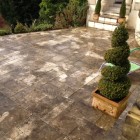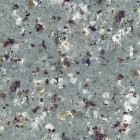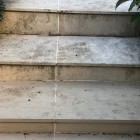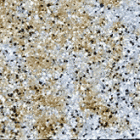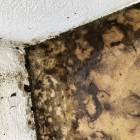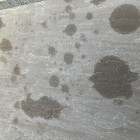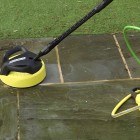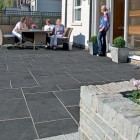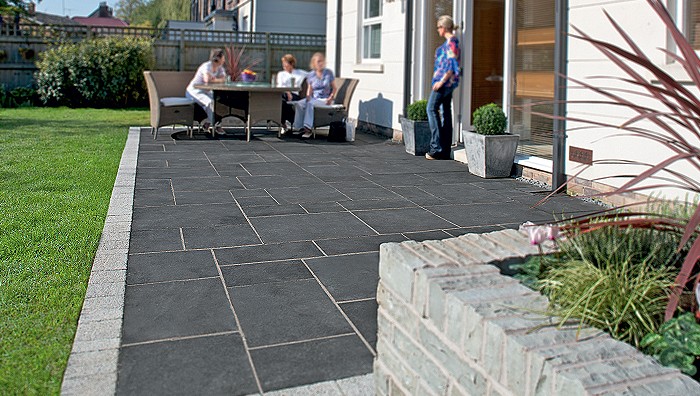
Cleaning Marshalls Limestone
Always follow instructions on the product labels, technical information and videos.
Always test products on a small area first.
Please Contact Us if you have any queries.
It is vitally important that you understand that you cannot use any acidic products on limestone which does make some cleaning jobs more difficult.
Applicable to all of Marshalls limestones including FAIRSTONE ALURI and SYLVERN etc.
Cement Staining
This is a difficult issue to resolve with a limestone because you must NOT use any acid based products. Cement residues are usually removed with an acid but you must NOT do this.
- You can use Powerase diluted 1:3 with water to help remove cement. You will need to scrub with brushes, nylon pads or machinery (on larger areas). You will see our recommended tools and equipment on the Product Pages.
- Allow a contact time of approximately 10 minutes. Keep the stone wet with solution throughout the cleaning process. You will need to work in small areas and avoid hot dry weather in order to be able to keep the stone wet.
- Be careful not to damage the stone by scrubbing too vigorously.
- Rinse well.
- ALWAYS do small test areas first.
- Results can be mixed but you will not damage your stone using this method. Again, do not use any acidic cleaning products on limestone.
You will find further instructions for using Powerase on the product page - please do read them.
Efflorescence (white mineral salts that can appear on a stone as it dries).
The same issues will be encountered as when removing cement residues from limestone because you MUST NOT use acidic products on limestone. Fortunately, efflorescence is not often an issue on limestone.
- If required, you can use Powerase diluted 1:3 with water to help remove efflorescence.
- You will need to scrub with brushes, nylon pads or machinery (on larger areas). You will see our recommended tools and equipment on the Product Pages.
- Allow a contact time of approximately 10 minutes. Keep the stone wet with solution throughout the cleaning process. You will need to work in small areas and avoid hot dry weather in order to be able to keep the stone wet.
- Be careful not to damage the stone by scrubbing too vigorously.
- Rinse well.
- ALWAYS do small test areas first.
- Results can be mixed but you will not damage your stone using this method. Again, do not use any acidic cleaning products on limestone.
​You will find further instructions for using Powerase on the product page - please do read them.​
​Rust
For rust removal please see the article below. Use the instructions for acid sensitive stones and DO NOT use Builderase or any other acidic product.
See the articles below, for instructions for how to remove various contamination from the above materials. Make sure you follow the instructions in the articles and on the relevant product pages.
Please contact us if you are struggling to achieve the best results or require further guidance.
Your Marshalls Limestone will be much easier to maintain if you have correctly sealed it. For further information about sealing click here or see the article, below.
Please click here to read our article on removing green and black algae and "black spot" from stone, tiles and pointing on external paths, steps and patios.
The products you will be using are Biorase which is sometimes followed up with Algex.
Bird droppings can cause severe staining on stone and tiles. We have seen areas covered in purple marks when they have been eating berries or green stains when the prefered food is caterpillars. You are likely to use Powerase and Biorase.
Please click here to see guidance, products and instructions.
The best methods for removing mud and general dirt from stone and tiles.
Rust staining is common in natural stone, cement based materials, block pavers and tiles. It can be naturally occurring or be caused by rusting items that are left on the stone, furniture, fixtures or lawn feed and weed type products.
This article will explain how to use Gel Rust and Builderase to remove almost all rust staining.
Leaves, trees, petals, seeds, pollen and cuttings can stain stone. Leaves can release tannin as they turn brown which is a very powerful dye. Tannin is the stuff in tea that can stain the inside of a glazed china teapot so it's not surprising that it will stain stone.
You will be using Biorase which is usually very effective.
Various food and drinks can stain stone. Oil and grease from a BBQ, children dropping ice cream or adults spilling a glass of wine can cause marks that are tricky to remove. Colours contained in food and drink can leave "coloured marks" even after normal cleaning. We are usually successful in removing this type of issue.
You need some knowledge to understand how to use a pressure washer in order to acheive the best results and avoid potentially serious damage.
Please read this article for guidance.
Don’t want to Do-It-Yourself? We can do the work for you or put you in touch with a contractor
Ask us a question or send us a picture of the problem and we will give you the benefit of 30 years of experience
